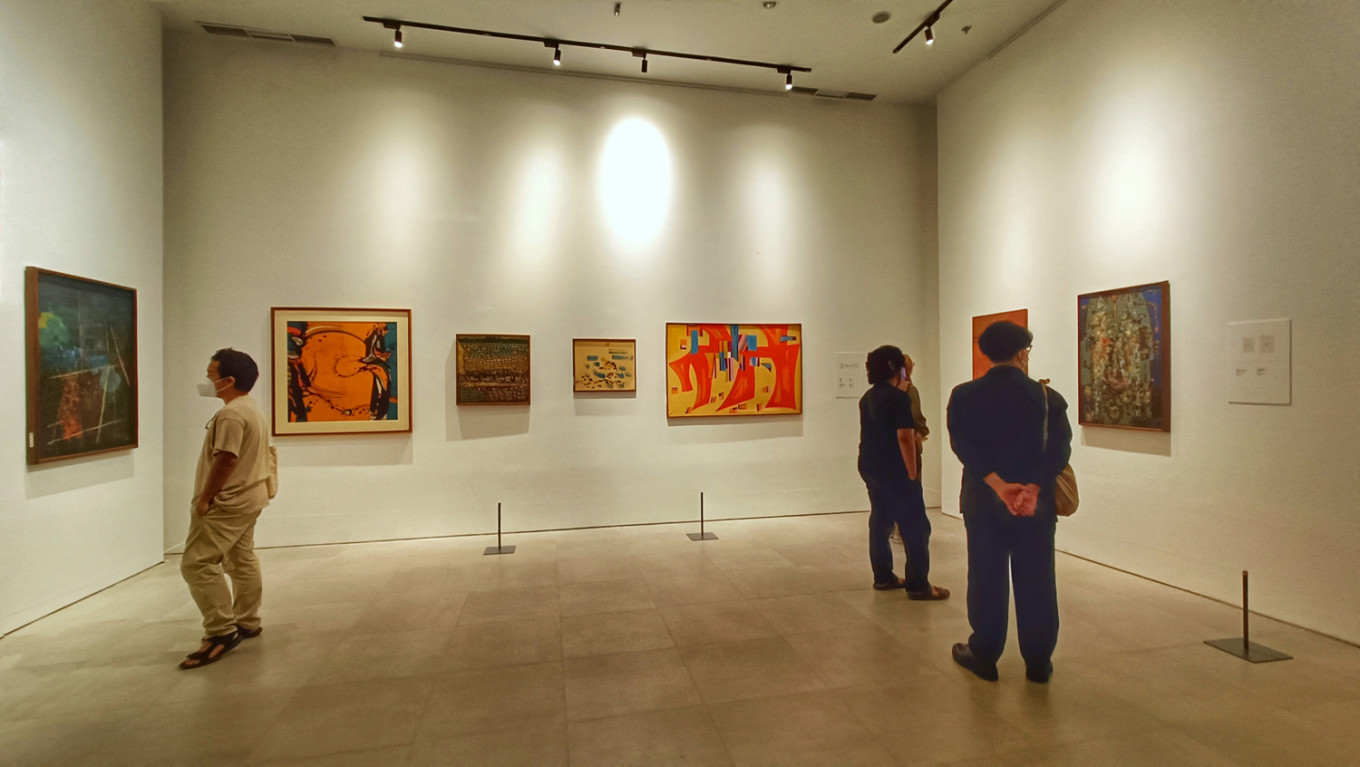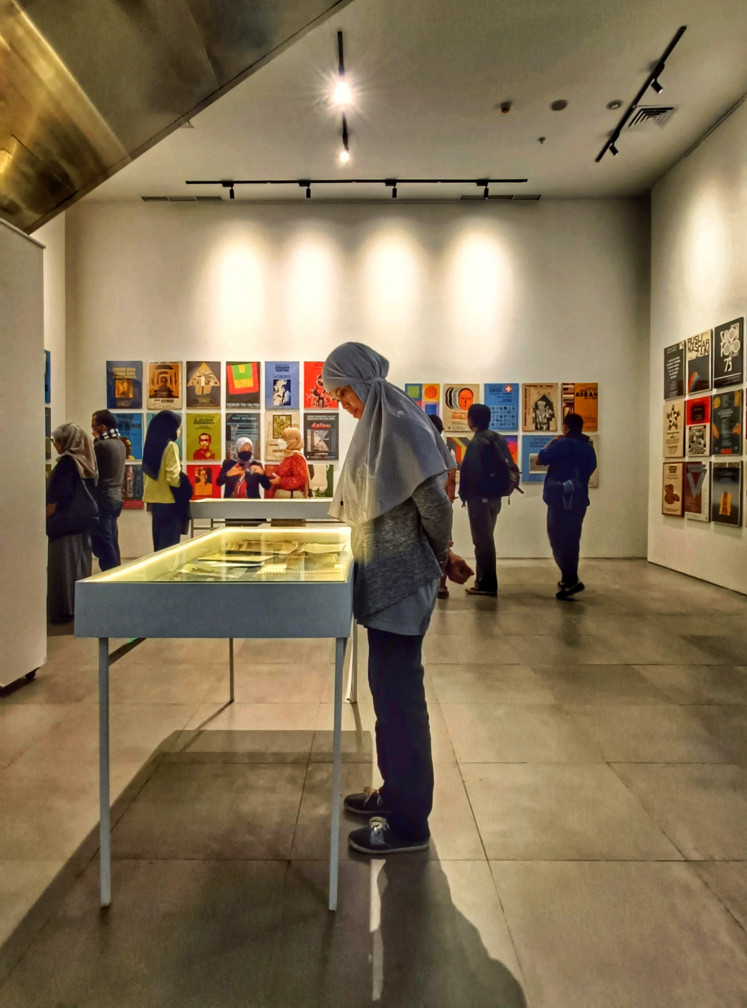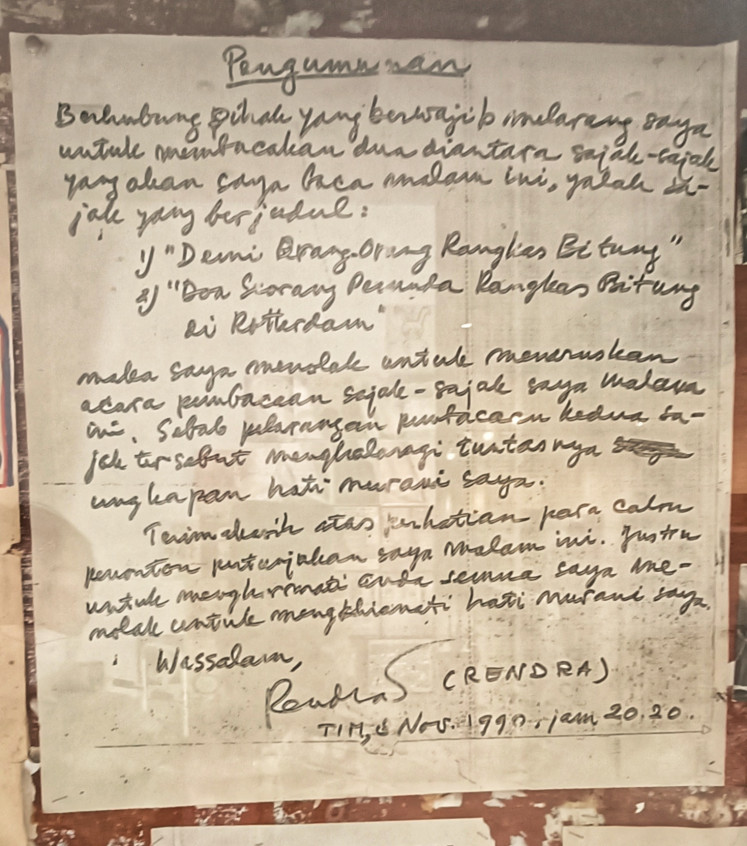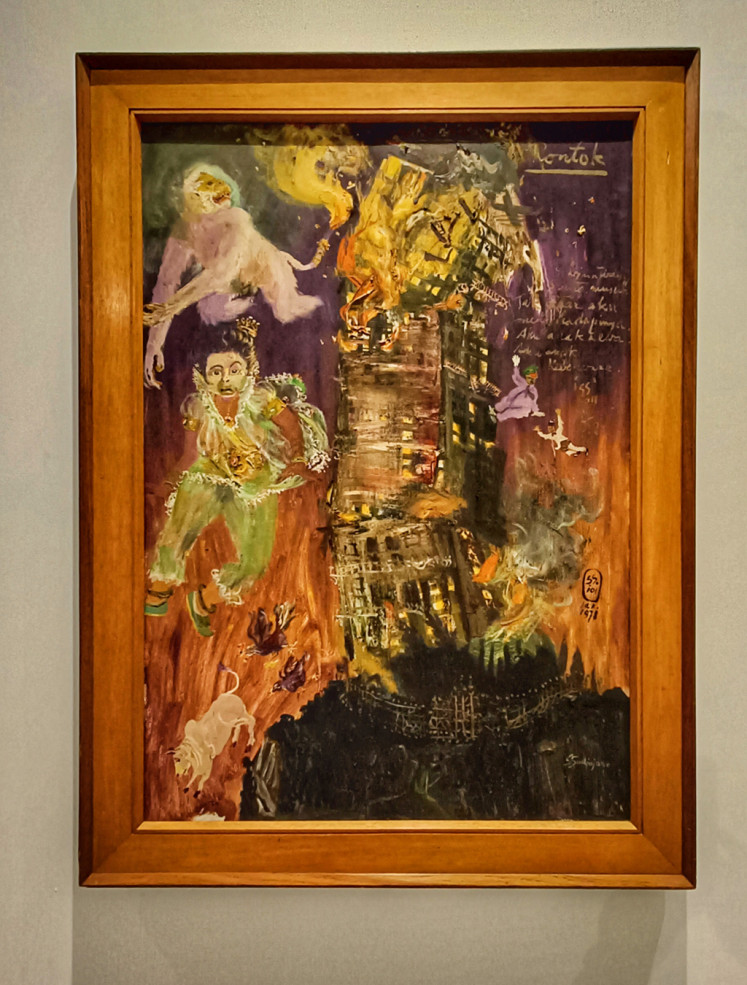Popular Reads
Top Results
Can't find what you're looking for?
View all search resultsPopular Reads
Top Results
Can't find what you're looking for?
View all search resultsJakarta Arts Council’s new exhibition casts Taman Ismail Marzuki in a new light
Change text size
Gift Premium Articles
to Anyone
F
or the soft opening of Taman Ismail Marzuki, the Jakarta Arts Council showcases some of its most notable archives and art collection.
Archives have leaped from their dusty boxes, taking center stage in the CIPTA! Kapita Selekta Cikini Raya 73 (CREATE! Select Capital from Cikini Raya 73) exhibition at Gedung Panjang, Taman Ismail Marzuki, Jakarta.
The exhibition, curated by the Jakarta Arts Council (DKJ), showcases some of the organization’s most noteworthy works of art and historical records between the 1960s and 1980s.
Running until July 16, the exhibition also marks the soft launch of Taman Ismail Marzuki (TIM) after undergoing major renovations that started in 2019.
“The new face of TIM presents new hopes, as well as challenges, to all art stakeholders in Jakarta,” Aidil Usman, chairman of the DKJ’s fine arts committee, said during the press conference on June 17. “Therefore, in our first program [after TIM’s revitalization], we are presenting an exhibition of the DKJ’s archives and art collections in order to bridge the past and the present.”
According to Aidil, the DKJ currently has 393 works of art in its collection, comprising graphic art, paintings and sculptures. The council has also preserved “tens of thousands” of audio and video recordings, newspaper clippings, photographs, posters, program books and speech notes in their archives,
In CIPTA! Kapita Selekta Cikini Raya 73, the council is displaying 60 paintings by Indonesian maestros, dozens of audio recordings of cultural debates and talks, hundreds of old photographs, newspaper clippings, program books and speech notes, as well as 70 posters of art scenes that took place in the establishment between the 1960s and 1980s.
Not just artwork: A visitor looks at old photos and documents in a vitrine at the CIPTA! Kapita Selekta Cikini Raya 73 exhibition. (JP/Sylviana Hamdani) (JP/Sylviana Hamdani)Long history
TIM was established on Jalan Cikini Raya No.73, Central Jakarta, by governor Ali Sadikin on Nov. 10, 1968, as the capital’s art center. The governor also assigned the DKJ to formulate programs and curate events taking place in the complex.
Over the years, TIM’s buildings and facilities have experienced a lot of wear and tear. Therefore in 2007, the provincial government held a design competition to revitalize the art complex. High-profile architect Andra Matin won the competition. However, Gubernatorial Decree (Pergub) No. 63/2019 to start the revitalization project was only issued in July 2019.
In the Pergub, the provincial government appointed PT Jakarta Propertindo (JakPro) to revitalize the eight-hectare complex and build new facilities required by the art center.
The revitalization project is currently in its finishing stages.
“This place will become a world-class cultural center and produce world-class creations by world-class Indonesian artists,” Jakarta Governor Anies Baswedan said in his speech during TIM’s soft launch and opening of the exhibition on June 17.
“The exhibition of the DKJ’s archives and art collections will offer the public the first experience of the new TIM as Jakarta’s modern art center,” the governor added. “And through the exhibition, we hope the younger generation will not only learn of the past, but also how to create great art in the future.”
Collections
On the public opening night of the exhibition on June 18, Jakarta’s art collective Cut and Rescue presented a unique multimedia performance, which combined the DKJ’s audio and video recordings, as well as documents and posters, in collaboration with indie-pop band White Shoes and The Couples Company’s drummer John Navid and punk rock band The Kuda’s vocalist Adipati.
It also presented an installation featuring the DKJ’s old office in the exhibition.
At the center of the installation is a glass-topped writing desk, featuring old pics of events taking place in TIM.
On its left is another table displaying a 1960’s audio mixer Sennheiser M101, reel-to-reel stereo recorder Uher 4200, video player Sony Betamax SL-8080E and vintage film projector Eumig S.
In the corner of the art installation are stacked neatly labeled boxes of archives and documents, as well as hundreds of cassette tapes of various performances held in TIM.
In another corner is TIM’s old bulletin board, featuring various photos, clippings and programs held at the art center. But the most notable among these items is a neatly handwritten note by legendary Indonesian poet WS Rendra, which announces the cancellation of his poetry reading in TIM on Nov. 8, 1990, because the authorities had forbidden him to read two of his poems that criticized the government at that time.
“These are treasures, not only of TIM and the DKJ, but also of the city and its younger generations,” Farah Wardani, chairwoman of the DKJ’s archives and art collections commission, said during her speech at the exhibition’s public opening on June 18.
“And they don’t only serve as mere nostalgia, but also as a tribute to noteworthy moments in history that we should never forget,” she added.
Besides these interesting documents and artifacts, visitors can listen to audio recordings of narrations and speeches by legendary Indonesian artists in pods lining the exhibition hall.
The exhibition also features the original speech and pictures of Jakarta’s governor Ali Sadikin when opening TIM on Nov. 10, 1968.
“It’s like a walk down history’s lane,” Adi Nugroho, student of the Jakarta Arts Institute (IKJ), said when interviewed on June 23. “It’s so interesting to know Bang Ali’s vision for TIM and see how his legacy has been continued and developed until now.”
Visitors can also see the original site plan of TIM in the exhibition.
The 60 paintings displayed in the exhibition represent several important phases in Indonesia’s fine arts development, including the Gerakan Desember Hitam (Black December Movement) in 1974, which gave birth to Gerakan Seni Rupa Baru Indonesia (New Indonesian Fine Art Movement, GSRBI).
GSRBI is deemed to be the foundation of Indonesia’s contemporary art.
Among works in this phase being displayed in the exhibition are the 1975 piece Bibir ‘75’ (Lips ‘75’) by Bonyong Muni Ardi, Pengumuman (Announcement) by Jim Supangkat also from 1975 and Hardi’s 1980 piece Suhardi Presiden RI 2001 (Suhardi President of the Republic of Indonesia 2001).
The exhibition also features masterpieces by Indonesian maestros, including Nashar, Popo Iskandar, S Sudjojono and Srihadi Sudarsono.
On display: 'Rontok', an oil-on-canvas painting by S Sudjojono in 1978. (JP/Sylviana Hamdani) (JP/Sylviana Hamdani)TIM in the future
The new face of Jakarta’s art center is scheduled to be launched in September.
And the DKJ has curated a lot of exciting art and cultural events taking place in TIM until the end of this year.
Among the upcoming events at TIM are the International Dance Film Festival in September, Jakarta International Literary Fest (JILF) in October and the International Ethnic Music Fest in November.
“The new face of TIM carries on the spirit of our predecessors,” Hasan Aspahani, chairman of the DKJ’s literary committee, said. “And its new buildings and state-of-the-art facilities also bring in a new hope for all of us.”














